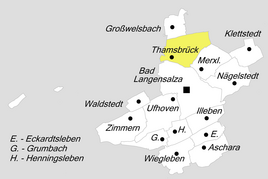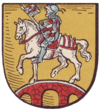Thamsbrück
|
Thamsbrück
City of Bad Langensalza
|
|
|---|---|
| Coordinates: 51 ° 8 ′ 21 ″ N , 10 ° 38 ′ 11 ″ E | |
| Height : | 183 m above sea level NHN |
| Area : | 12.55 km² |
| Residents : | 952 (Dec. 31, 2015) |
| Population density : | 76 inhabitants / km² |
| Incorporation : | March 8, 1994 |
| Postal code : | 99947 |
| Area code : | 03603 |
|
Location of Thamsbrück in Bad Langensalza
|
|
|
Town hall on the market
|
|
Thamsbrück (also Ablassstadt Thamsbrück ) is a district of the city of Bad Langensalza in the Unstrut-Hainich district in Thuringia (Germany), about 35 kilometers northwest of Erfurt , with 952 inhabitants. The town, which has been independent since 1206, was incorporated into Bad Langensalza in 1994.
Thamsbrück is the oldest small town in Thuringia and has a tradition of more than 500 years with the indulgence festival .
geography
Thamsbrück is located in the west of the Thuringian Basin about four kilometers north of Bad Langensalza at an altitude of 175 meters above sea level . The area is dominated by agriculture. On the south and west edge of the village, the Unstrut , with two rivers, flows east to the Saale. The Welsbach coming from the north flows into the Unstrut on the north-west side of the village.
history
Thamsbrück is mentioned for the first time in 736. It describes that the church in Thamsbrück was founded by the Anglo-Saxon missionary Bonifatius . In 1149 Ludwig the Iron had a castle built for his brother Ludwig the Younger on the hill in front of the Unstrut . In 1206, Thamsbrück was certified in a deed of gift by Landgrave Hermann I and named civitas (Latin for city) when a Mühlhauser arbitration award was confirmed. This is commonly seen as the first mention of city law. Until 1490, Thamsbrück Castle formed the center of a landgrave's office, then it became part of the Langensalza office . On June 20, 1500, 30 Thamsbrückers returned from a campaign against rebellious Frisians who had revolted against the governor of Friesland, the Wettin Heinrich the Pious .
Thamsbrück belonged to the Electoral Saxon Office Langensalza until 1815 and, after its cession to Prussia, from 1816 to 1944 to the district of Langensalza in the province of Saxony . In 1868 Thamsbrück Castle was demolished and the area, including the moat, was converted into a garden. The castle tower, however, was spared. In 1890 the malt factory "Schloss Thamsbrück" was founded.
A portrait of the city published in 1975 mentions the LPG "Karl-Marx" , which is combined with a part of the operation in Großwelsbach , as the main agricultural company, as well as the two local malt factories, the VEB "Feuerteufel" and the only mill construction company "ORANO" that remained in the GDR Production of millstones took over.
In Thamsbrück was one of four dinghies of the Thuringian Regional Court in Mittelhausen .
The city name and its development
The name of the city of Thamsbrück has changed slightly over 1200 years, since the place was proven to have existed. In the first sources from the years 780 and 802 the monastery at Fulda received income from Tungesbrucgen . From 1174 the local landgrave ministries de Tungeßbrucken ( called Thungisbrucken ) are mentioned in several sources. In 1206, the year in which the place received its town charter, it was Tungesbrucken . In 1315 it was Dungisbrukin . In the years 1318 and 1319 it was again, as in 1206, Tungesbrucken . 1328 Tungis Bridge . Besides Thungispruken and Tungesbrucke (s) also be Tumesbrucken , Thomas Bridges , Thoms bridges in Lehnbuch the Severe Frederick recorded. In other sources it said 1445 Thomesbrugken , 1526 Thommesbrugk and 1724 Thambsbrück .
The name Thamsbrück may have developed in the first member Thams from the Germanic personal name Dung , or Tung , which is a vowel variant of the Old High German thing ( ding ). Thing here means people's assembly or court hearing . In addition, T (h) oms and T (h) ams are short forms for biblical Thomas. The second link brück belongs to the Middle High German -brücke , or Middle Low German -bruges .
Incorporations
Through the Thuringian Restructuring Act (ThürNGG), which came into force on June 1, 1994, the previously independent city was incorporated into the city of Bad Langensalza on March 8, 1994.
politics
District Mayor
The district mayor of Thamsbrück is Björn Goldmann.
coat of arms
The municipal coat of arms of the then city of Thamsbrück is historical. It dates from 1270 and is of unknown origin.
| Blazon : “In gold on a red , rounded, three-arched bridge , a silver rider in armor with silver armor on a white horse with a red saddle and harness. The rider holds a shield in his lefthand and a flag in his right. On the flag and the sign is the same in each case Leo , seven of red and silver divided , stylized shown. " | |
| Reasons for the coat of arms: The Thamsbrück coat of arms with the bridge is a talking coat of arms . In the tab, it should be around the Landgrave of Thuringia, I. Hermann act. |
Culture and sights
Buildings
- St. Georg Church : The parish of Thamsbrück in the Evangelical Church District Mühlhausen includes the communities Bothenheilingen , Großwelsbach , Issersheilingen , Kleinwelsbach , Merxleben and Neunheilingen .
- town hall
- Nikolausturm
Regular events
In Thamsbrück, the festival of indulgences is traditionally celebrated on the weekend whose Sunday is the first in July.
societies
There is a pronounced club life in Thamsbrück. In addition to the usual clubs such as the carnival, football and bowling club and the volunteer fire brigade, the Heimat- und Ablaßburschenverein 1501 e. V. and the Tambour-Corps 1924 Thamsbrück e. V. worth mentioning.
Photo gallery
Personalities
Sons and daughters of the place
- Otto Just (1854–1931), ministerial official
- Ulrich Fleischhauer (1876–1960), anti-Semitic publicist and publisher
- Hermann Ludwig Blankenburg (1876–1956), composer, referred to as "March King", honorary citizen of the city
People connected to the place
- Balthasar Wurmb (1532–1598), electoral Saxon secret councilor and governor, among the feudal estates assigned to him was a share in Thamsbrück
- Johann Josua Löner (1535–1595), Lutheran theologian, rector in Thamsbrück (1558–1561)
- Georg Vitzthum von Eckstedt (1551–1605), Electoral Saxon Privy Councilor and Appellate Council in Dresden and Captain zu Thamsbrück
- Carl Heinrich von Berlepsch (1694 – after 1779), Major General of Infantry from the Princely Würzburg, Colonel over a regiment on foot and court war councilor and finally Lieutenant General Field Marshal, he inherited their father's possessions in Thamsbrück together with his four brothers
- Erich Volkmar von Berlepsch (1707–1749), Princely Saxon governor in Weißenfels, was in the service of the Duke of Saxony-Weißenfels, later district commissioner and lastly royal Polish and electoral Saxon district chief in Thuringia, inherited Thamsbrück after the death of his father 'Sche Vorwerk
- Eberhard Ladwig (1923–2006), botanist, worked from 1950 at the Pedagogical Institute in Mühlhausen and from 1969 at the Erfurt / Mühlhausen University of Education, where he was a university lecturer in biology (1969–1988), was a teacher in Thamsbrück
literature
- Heinz Lange, Karl Siegfried Melzer, Helmut Goldmann, Fritz Görlach: The city of Thamsbrück - contributions to local history. Self-published, Thamsbrück 2001.
Web links
Individual evidence
- ^ Municipalities in Germany by area and population. (XLSX; 1.6 MB) See under: Thuringia, No. 15793 . In: Destatis website. Federal Statistical Office, December 31, 1992, accessed on November 2, 2019 .
- ↑ a b c Information on the Thamsbrück district. In: Website City of Bad Langensalza. December 31, 2015, accessed March 3, 2019 .
- ↑ Waltraut Läschke: From the millstone to the "fire devil" . Small towns in our district. We introduce: Thamsbrück. In: The people . 1st February 1975.
- ^ Ernst Eichler , Hans Walther : City name book of the GDR. Bibliographisches Institut, Leipzig 1986, ISBN 3-323-00007-2 , p. 273 ff.
- ^ Thuringian State Office for Statistics.







